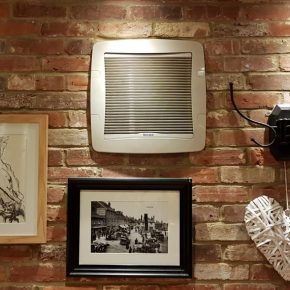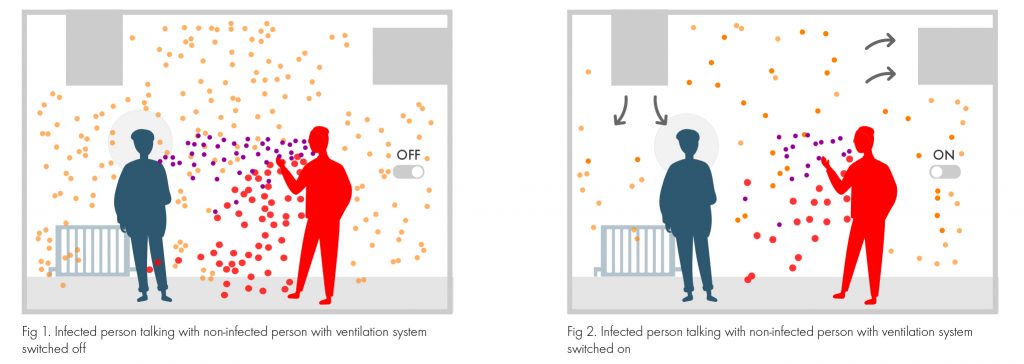
Vent-Axia welcomes editorial published in BMJ on ventilation reducing COVID-transmission
With further easing of lockdown restrictions on 17 May, pubs, restaurants, gyms, offices and other businesses should prepare for reopening by checking and improving their ventilation, says Vent-Axia.
The vital importance of good ventilation in helping reduce transmission of COVID-19 features in new advice in an editorial in the British Medical Journal (BMJ) ‘Covid-19 has redefined airborne transmission’.
According to experts in the editorial, any future attempts to reduce the spread of COVID-19 should be focused on tackling close airborne transmission of the virus which is considered to be the primary route for its circulation.
They highlight ‘the need for added emphasis on ventilation because the tiniest suspended particles can remain airborne for hours, and these constitute an important route of transmission’

Vent-Axia welcomes this latest advice
Ventilation industry leader Vent-Axia welcomes this latest advice, which adds to the raft of evidence and guidance that supports ventilation as key to making indoor spaces safer.
As we start to unlock from the latest lockdown, effective ventilation will prove a crucial tool in helping to prevent a rise in infection rates. The Government has confirmed this with its recent Public Health England guidance ‘Ventilation of indoor spaces to stop the spread of coronavirus’ which explains the importance of ventilation in stopping the spread of coronavirus.
However, the BMJ editorial also shares other business benefits from improving ventilation, apart from helping tackle COVID-19. With better ventilation, indoor air quality will improve for businesses, reducing sick leave for other respiratory viruses, as well as helping those with allergies.
Lower absenteeism and improved productivity could save costs for companies, which in turn would offset the cost of a ventilation upgrade.
The editorial also recognises the likelihood of COVID-19 possibly becoming a seasonal virus like the flu. Therefore, any improvements in ventilation will be beneficial in both the long and short term.
‘Critical role’
Jenny Smith, Head of Marketing at Vent-Axia, comments: “We welcome this latest advice from the experts set out in the BMJ editorial which once again highlights the critical role ventilation plays in reducing coronavirus transmission – something that is essential to help us return to some kind of normality.
“Now is the time to check ventilation to ensure there is enough airflow to dilute the virus in the air and improve indoor air quality. Ventilating for longer and opting for ventilation with higher airflow volumes will help reduce the risk.
“At Vent-Axia our knowledgeable ventilation consultants can offer advice on the most suitable ventilation for each setting to help make buildings COVID-secure. We also have an excellent spares department to help ensure any existing ventilation is in full working order.”
The editorial in the BMJ is backed up by the Government’s guidance, from early March. ‘Ventilation of indoor spaces to stop the spread of coronavirus’ explains how coronavirus is spread and the vital role ventilation plays in reducing the risk of catching the virus.
The guidance looks at how to improve ventilation in both domestic and commercial settings. In addition to opening windows and doors, it details the importance of making sure any mechanical ventilation is working properly. It also looks at how ventilation systems should be set to bring fresh air in and not recirculate indoor air.
It states that in workplaces, clear guidance on ventilation should be available to all employees and ventilation should be a part of making your workplace or indoor public space COVID-secure.
If unsure, it also recommends seeking advice from an HVAC engineer to ensure ventilation systems meet current standards.
Knowledge of COVID-19
This latest COVID guidance builds on extensive existing research and advice. Upon the first UK lockdown in March 2020, relatively little was known about COVID-19.
However, changes took place over the course of the year. At the beginning, the possibility of airborne transmission of COVID-19 was a consideration but, as a novel virus, it was important to gather evidence to prove this.
Early on in the pandemic, the importance of ventilation was already receiving recognition. At a COVID-19 briefing on 29 April 2020, Deputy Chief Medical Officer Professor Jonathan Van-Tam confirmed ventilation lowers transmission rates from respiratory viruses.
‘There is a definite truism across all of the science literature, that ventilation is a most critical part of reducing transmission from respiratory viruses,’ Jonathan Van Tam.
And since this press briefing, the evidence has continued to build. In May 2020, the Government’s COVID-19 return to work strategy was published, citing ‘Keep Indoor Places Well Ventilated’ as one of the key principles.
The strategy states ‘evidence suggests that the virus is less likely to be passed on in well-ventilated buildings and outdoors’ and advises to ‘use external extractor fans to keep spaces well ventilated and make sure that ventilation systems are set to maximise the fresh air flow rate’.
In November, a Government public information campaign highlighted how ventilating indoor spaces can reduce the risk of coronavirus infection by over 70%.
A short film, part of the campaign, shows how coronavirus lingers in enclosed spaces, and tips on ventilating homes efficiently.
World Health Organisation acknowledgement
The campaign followed The World Health Organisation’s (WHO) acknowledgment that ‘Ventilation represents a very important factor to prevent the virus from spreading indoors’.
Public Health England’s guidance ‘COVID-19: epidemiology, virology and clinical features’ acknowledges airborne transmission can occur in ‘poorly ventilated’ spaces. Meanwhile the Government’s ‘Hands, Face, Space and Fresh Air’ public information campaign includes a film highlighting the impact of fresh air on reducing the risk of transmission.
Throughout the pandemic Vent-Axia has been sharing the latest guidance and valuable expert advice on the positive effect of ventilation in helping tackle COVID-19, on improving indoor air quality and creating a healthy environment while working from home.
This body of essential information is in this useful guide – ‘The Effect of Ventilation on COVID-19’. There is also a companion webpage – https://www.vent-axia.com/dilutethevirus. This gives practical advice on how indoor ventilation is important to reduce virus transmission.
Latest news

28th March 2025
Ideal Heating Commercial announces 10-year warranty on Evomax 2 boiler
Evomax 2, the UK’s number one selling commercial wall-mounted boiler from Ideal Heating Commercial, is now available with a 10-year warranty.
Posted in Articles, Building Industry News, Building Products & Structures, Building Regulations & Accreditations, Building Services, Facility Management & Building Services, Heating Systems, Controls and Management, Heating, Ventilation and Air Conditioning - HVAC, Innovations & New Products, Pipes, Pipes & Fittings, Plumbing, Retrofit & Renovation, Sustainability & Energy Efficiency, Videos
28th March 2025
FLIR Si1-LD Acoustic Imaging Camera for Compressed Air Leak Detection
FLIR, a Teledyne Technologies company, introduces the Si1-LD, an industrial acoustic imaging camera that brings faster and more accurate compressed air leak detection to those operating on a modest condition monitoring budget.
Posted in Acoustics, Noise & Vibration Control, Articles, Building Industry News, Building Products & Structures, Building Services, Facility Management & Building Services, Information Technology, Innovations & New Products, Retrofit & Renovation, Sustainability & Energy Efficiency, Thermal Imaging and Monitors
28th March 2025
LIFTEX 2025 Seminar programme announced
Registration has opened for LIFTEX 2025. Now in its 37th year, LIFTEX 2025 is the UK’s only dedicated exhibition for the lift, escalator and access industry and takes place only once every three years.
Posted in Access Control & Door Entry Systems, Accessibility, Articles, Building Industry Events, Building Industry News, Building Products & Structures, Building Regulations & Accreditations, Building Services, Exhibitions and Conferences, Facility Management & Building Services, Health & Safety, Retrofit & Renovation, Security and Fire Protection, Seminars
28th March 2025
MCRMA welcomes ArcelorMittal UK to membership
A UK division of the global steelmaking business ArcelorMittal has become the latest new member of the MCRMA, the industry association representing the metal building envelope sector.
Posted in Articles, Building Associations & Institutes, Building Industry News, Building Products & Structures, Building Systems, Cladding, Facades, Posts, Restoration & Refurbishment, Retrofit & Renovation, Roofs, Steel and Structural Frames, Walls
 Sign up:
Sign up: